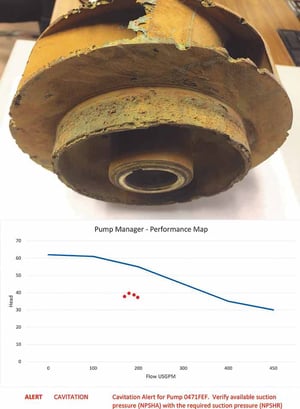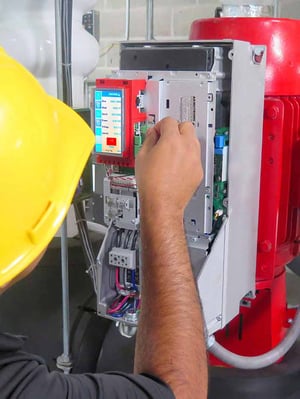As Seen On: pumpsandsystems.com - August 28, 2019
 There are many stories of expensive pump repairs and performance problems brought on by cavitation. In one case, a municipal water department was replacing impellers for its reservoir feed valve every 18 months, for years, until engineering efforts produced an accurate diagnosis and resolution.
There are many stories of expensive pump repairs and performance problems brought on by cavitation. In one case, a municipal water department was replacing impellers for its reservoir feed valve every 18 months, for years, until engineering efforts produced an accurate diagnosis and resolution.
In another instance, a power plant was regularly forced to spend millions of dollars to shut down, dismantle, transport, repair and re-install cooling water pumps before it understood the root problem and an effective remedy. If high cost is not a serious enough issue, there have also been reports of pumps exploding and motors flying through concrete walls, which suggests that someone could be seriously injured or even killed by the effects of cavitation.
System Performance
Well before equipment runs to failure, cavitation can quietly ravage an operating budget. Cavitation reduces flow performance, which can lead to increased power consumption, and can cause serious wear on seals and bearings. Associated noise can create occupant reactions and even minor leaks can cause unwanted cleanup expenses.
Writing in Pumps & Systems a year ago, Jim Elsey noted that, “When the bubbles collapse near or at the metal surface, they collapse asymmetrically and cause a small microjet. This collapse occurs on a nanoscale (1.0 x 10-9 or billionth). Local pressure forces involved can be higher than 10,000 pounds per square inch gauge (psig) (689 bar) or more, plus there is heat generated.
“This phenomenon can occur at frequencies up to 300 times per second and at speeds near the speed of sound.”
It Is Complicated
Occasionally, journal articles from a variety of experts appear, presenting structured breakdowns of the types of cavitation damage, their causes and solutions. Meanwhile, the average engineer acknowledges that cavitation is not simple to diagnose, and often even more difficult to correct. In the “Centrifugal Pump User’s Guidebook: Problems and Solutions,” published in 2012, Appendix A contains a checklist of pump problems and their causes. Under “Pump is operating with noise or vibrations, or both” it mentions cavitation, plus 41 other possible explanations.
It is true that symptoms indicating cavitation might also signal air entrapment, suction recirculation or discharge recirculation. It can be expensive to determine the problem, before any consideration is given to the cost of solving it via shutdown, draining the system, service personnel, redesign, new components, downtime and more. The good news is that technology has evolved to provide more precise information.
Connected Systems & Data Analysis
 Intelligent fluid management systems now include internet connectivity and the capability to gather existing data of operating occurrences. It is also possible to capture and store patterns and trend lines in the cloud. Contemporary algorithms can analyze the data and provide insight into the workings of mechanical systems and components with a level of statistical accuracy that was previously unavailable.
Intelligent fluid management systems now include internet connectivity and the capability to gather existing data of operating occurrences. It is also possible to capture and store patterns and trend lines in the cloud. Contemporary algorithms can analyze the data and provide insight into the workings of mechanical systems and components with a level of statistical accuracy that was previously unavailable.
Fluid management engineers with major technology manufacturing firms now rely on a wider variety of analytic processes aimed at reviewing history and predicting the future. Vibration, performance data, operating pressure and temperature variations are all analyzed to develop models that will lead to reliable diagnoses of fluid management challenges and recommendations on preventive measures.
Failures of different types, including issues with shafts, bearings, seals or cavitation, exhibit a unique signature.
Even within a given type of failure, there are different signatures. Examples include early onset cavitation, moderate cavitation, critical cavitation or complete failure caused by cavitation. If pumps are cavitating, the pumps are likely not the problem. The actual causes can be numerous, including suction pressure below normal, clogged strainers or leaking valves. It will soon be possible for data analytics teams to suggest which of these is the likely culprit.
Smart Commissioning
The same departments making a science out of diagnosing and preventing catastrophic failures are learning with more precision about system performance and ongoing commissioning. When purchasing intelligent pumps and controls for a mechanical room, the pumps can now be installed and commissioned, and then ongoing performance tracking can be added along with tweaking for continuous performance improvements. As best practices are more precisely defined, based on systems around the world, fluid management can improve in real time.
This is valuable in almost any situation involving intelligent engineered systems, and even more so when the facilities teams are large and the assets expansive. Big complexes and campuses can experience personnel turnover that can disrupt performance and the dissemination of learning. Ongoing performance tracking and data collection can provide data succession and commissioning continuity to support the efforts of incoming engineering personnel and ensure organizational goals are met.
Data Does Not Have an Opinion
Another valuable dimension of this technological advancement is that it allows an enterprise to welcome the new data-driven world.
There are stories of the stereotypical curmudgeonly engineer who has been in residence forever and is convinced of his own wisdom regarding long-standing systems problems and how nothing can be done to fix them. Although this character is fictional, there may be some individuals who struggle to keep an open mind. Sometimes narrow thinking is a contributing factor in poor system performance or continued inordinate maintenance costs.
Here is where data can save the day. Accurate data can provide an unbiased assessment of what is really happening. As the databases and analytics continue to develop, solutions will be identified with increasing precision and, in some cases, dramatic results.
Anomalies & Alerts Case Study
In one example, an integrated pumping system had been installed and a subscription data gathering function was enabled. Everything was fine until alerts regarding an anomaly were received, and the user was advised.
The team helped the user focus on the possible scenarios. Following a physical investigation, it was determined that the facilities team had recently replaced the valves and drained the system, but the system had not been properly refilled. There were still pockets of air in it. Thankfully, the issue could be corrected quickly. Running a pump intermittently dry could have resulted in burned-out motors or a greatly reduced life span for the motors—five years rather than 20.
Manual Settings
Fluid management data labs have discovered that one habit of some facility managers and engineers is the unnecessary use of pump-in-hand, also known as manual settings. Manually selected speeds and sequences may or may not be a good idea with properly commissioned intelligent control systems. Algorithms have already been developed that can calculate the efficiency differences between manual selections and optimum settings determined by modern controls. Still, technicians routinely find one or more pumps set to “Hand Mode,” underserving the system (not delivering enough pressure) or wasting energy (creating too much pressure).
For smarter commissioning, extended performance efficiency, anomaly alerts, adding new best practices or predicting failures, an intelligent, connected system with analytics capability offers compelling advantages.
Also Seen On:



